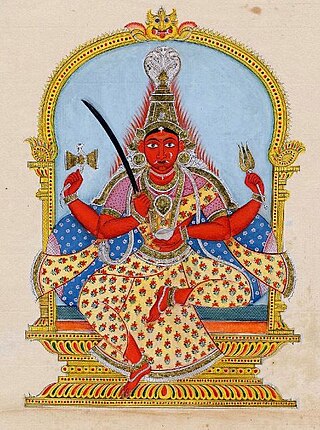
Mariamman, often abbreviated to Amman, is a Hindu goddess of weather, predominantly venerated in the rural areas of South India. Her festivals are held during the late summer/early autumn season of Ādi throughout Tamil Nadu and the Deccan region, the largest being the Ādi Thiruviḻa. Her worship mainly focuses on bringing rains and curing diseases like cholera, smallpox, and chicken pox. Mariamman is worshipped in accordance with local traditions such as Pidari or the Gramadevatai. She is considered as a guardian deity by many South Indian village-dwellers.

The Adikesava Perumal Temple is a Hindu temple located in Thiruvattar, Kanyakumari district, Tamil Nadu, India and is one of the 108 Divya desams, the holy sites of Hindu Vaishnavism according to existing Tamil hymns from the seventh and eighth centuries C.E. The temple is one of the historic thirteen Divya Deshams of Malai Nadu. The temple is a picturesque setting surrounded on three sides by rivers namely, It was the Rajya Temple and Bharadevatha shrine of Erstwhile Travancore. After state reorganisation, the temple handed over to Tamilnadu H&RCE Dept. The presiding Vishnu in the form of Ananthapadmabhan/Adikeshavaperumal is believed to be older than Padmanabhaswamy Temple in Thiruvananthapuram. Since Vishnu resides here in a reclining position, and is surrounded by rivers, the temple is called as "The Srirangam of Chera Kingdom".
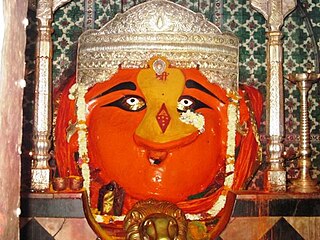
Renuka, also known as Yellamma, is a Hindu mother Goddess worshipped predominantly in the South Indian states of Karnataka, Tamil Nadu, Telangana, Kerala, Andhra Pradesh and the western state of Maharashtra. She is the mother of Parashurama, the sixth avatar of god Vishnu. She was given the name "Renuka" and acquired the status of a mother goddess before eventually being associated with the legend of Parashurama.
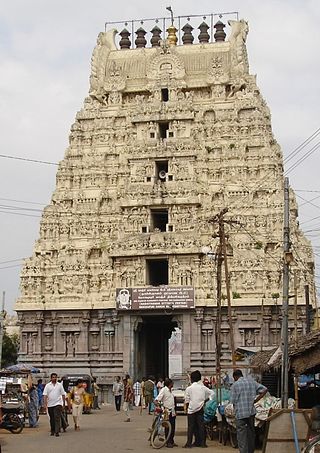
The Kamakshi Amman Temple, also known as Kamakoti Nayaki Kovil, is a Hindu temple dedicated to the goddess Kamakshi, one of the highest aspects of Adi Parashakti, the supreme goddess in Shaktism. The temple is located in the historic city of Kanchipuram, near Chennai, India.
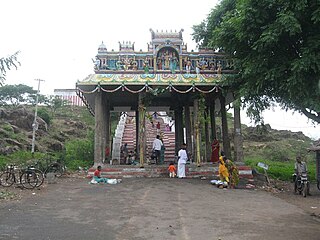
Kundrathur is a town located in the Chennai Metropolitan Area and the headquarters of Kundrathur taluk in Kanchipuram District. It is the birthplace of Sekkizhar, a well-known poet-saint who authored the Periyapuranam.

Sadasiva Brahmendra was a saint, composer of Carnatic music and Advaita philosopher and Sishya of the Great saint Shri Paramasivendra Sarasvati, who lived near Thiruvenkadu, Tamil Nadu, during the 15th/16th century. Even Today, many saints from big and small mathas come and prostrate at his adhisthanam to pay their respects to him and his guru parampara. Unfortunately only a few of his compositions have survived, but they are recognized as great compositions of Carnatic music.

The Sri Mahamariamman Temple is the oldest Hindu temple in Kuala Lumpur, Malaysia. Founded in 1873, it is situated at the edge of Chinatown in Jalan Bandar. In 1968, a new structure was built, featuring the ornate 'Raja Gopuram' tower in the style of South Indian temples.

The Arulmigu Sri Mahamariamman Temple is a Hindu temple within George Town in the Malaysian state of Penang. The oldest Hindu temple in the state, it was built in 1833, and features sculptures of gods and goddesses over its main entrance and facade.

The Nellaiappar Temple is a Hindu temple dedicated to the deity Shiva, located in Tirunelveli, a city in the South Indian state of Tamil Nadu. Shiva is worshipped as Nellaiappar represented by the lingam and his consort Parvati is depicted as Kanthimathi Amman. The deity Vishnu is also worshipped here, having witnessed their wedding according to legend. Hence, this temple is regarded as an abhimana kshetram of Vaishnavism. The temple is located on the northern banks of Thamirabarani River in Tirunelveli district. The presiding deity is revered in the 7th century Tamil Saiva canonical work, the Tevaram, written by Tamil saint poets known as the nayanmars and classified as Paadal Petra Sthalam.

Marundeeswarar Temple is a temple dedicated to Hindu deity Shiva, located in Thiruvanmiyur, Chennai adjacent to the beach of Bay of Bengal. It is one of the 275 Paadal Petra Sthalams where two of the most revered Nayanars, Appar and Tirugnana Sambandar, have glorified the temple with their verses during the 7th century CE. The temple has been widely expanded by Chola kings during the 11th century CE. The temple has two seven-tiered gateway towers, a huge tank, with the overall temple area covering 1 acre. The Marundeeswarar temple has been a place of curative worship for people with diseases.
Sacchidananda Bharati I , was a Hindu sant and religious leader of the 17th century. He was the Jagadguru of the Hindu matha Sringeri Sharada Peetham from 1623 to 1663, and is believed to have saved it from attack by spiritual means.
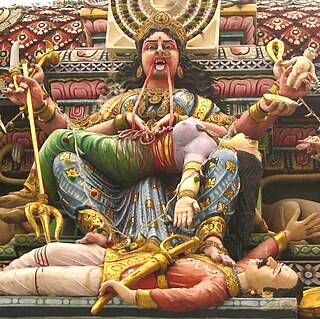
Periyachi is a ferocious aspect of Parvati in Hinduism. She is also known as Periyachi Amman and sometimes called as Periyachi Kali Amman as she is associated with the goddess Kali. According to some accounts, the deity is a Guardian form of the Mother Goddess, who is prayed to in order to prevent misfortune during childbirth. Periyachi is said to be the protector of children, and is associated with childbirth and pregnancy, and is a deity revered in Singapore, The Caribbean, Malaysia and Réunion Island.
H. H. Swami Santhananda Saraswati Avadhoota Swamigal born as Subrahmanyam was a Hindu spiritual leader and teacher who established the worship of Devi Bhuvaneswari in Tamil Nadu. He was the founder of the Bhuvaneswari Peetam in Pudukkottai, Tamil Nadu, India. The very embodiment of Prema, Sri Sri Swami Santhananda was the fountainhead of Hindu Dharma and Vedic principles. In his lifetime he had conducted several yagnas as elucidated in the Sasthras and challenged orthodoxy by bringing to light, guarded Moola Mantras that ensure common good, wealth and peace.

Thambiluvil Kannaki Amman Kovil is one of the most significant Hindu temples in the Ampara District of Eastern Province, Sri Lanka. It is situated about 70 km (43 mi) south of Batticaloa and 11 km (6.8 mi)— south to Akkaraipattu. It is considered as one of the ancient temples of Mattakkalappu Desam made for Kannaki Amman, the heroine of the great Tamil epic Silappatikaram.

Vandiyur Mariamman Teppakulam is a temple tank located near to Vandiyur Mariamman Temple and situated at a distance of about 5 km from the Meenakshi Amman Temple. Literally, Teppakulam means temple pond mainly used for devotional festivals.

Nainativu Nagapooshani Amman Temple [Tamil: நயினாதீவு நாகபூசணி அம்மன் கோயில், romanized: Nayiṉātīvu Nākapūcaṇi Am'maṉ Kōyil - Meaning: Nainativu ; Nagapooshani ; Amman (Goddess)] is an ancient and historic Hindu temple located amidst the Palk Strait on the island of Nainativu, Sri Lanka. It is dedicated to Parvati who is known as Nagapooshani or Bhuvaneswari and her consort, Shiva who is named here as Nayinaar. The temple seems to have been mentioned in the Brahmanda Purana. The temple complex houses four gopurams ranging from 20–25 feet in height, to the tallest being the eastern Raja Raja Gopuram soaring at 108 feet high. The temple is a significant symbol for the Tamil people, and has been mentioned since antiquity in Tamil literature, such as Manimekalai and Kundalakesi. The present structure was built during 1720 to 1790 after the ancient structure was destroyed by the Portuguese in 1620. The temple attracts around 1000 visitors a day, and approximately 5000 visitors during festivals. The annual 16-day Mahostavam (Thiruvizha) festival celebrated during the Tamil month of Aani (June/July) - attracts over 100,000 pilgrims. There is an estimated 10,000 sculptures in this newly renovated temple.
Velleswarar Temple is a Hindu temple dedicated to Lord Shiva and located in Mangadu, a suburb of Chennai, India. This is a mid-size temple spread over 2 acres and is among the 3 principal temples in Mangadu – the other 2 being the Sri Kamakshi Amman Temple and Sri Vaikunda Perumal Temple. The temple is managed by the HRCE Department of the Government of Tamil Nadu. It is situated about 2 kilometers from Sri Kamakshi Amman Temple in Mangadu.

The Bhu Varaha Swamy temple is a Hindu temple, located at Srimushnam, in the South Indian state of Tamil Nadu. Constructed in the South Indian style of architecture, the temple is dedicated to Varaha, the boar-avatar of the god Vishnu and his consort Lakshmi as Ambujavalli Thayar. It is Classified one among the 108 Abhimana Kshethram of Vaishnavate tradition. One of the greatest Hindu scholars of Vaishnava Tattvavada (Dvaita) philosophy, Madhvacharya, have come and resided in this temple many times.














